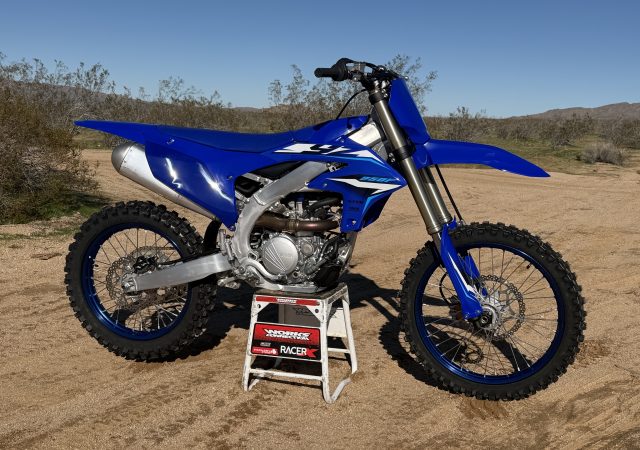
For this edition of Classic Steel, we are going to take a look back at Yamaha’s all-new YZ250G for 1980.
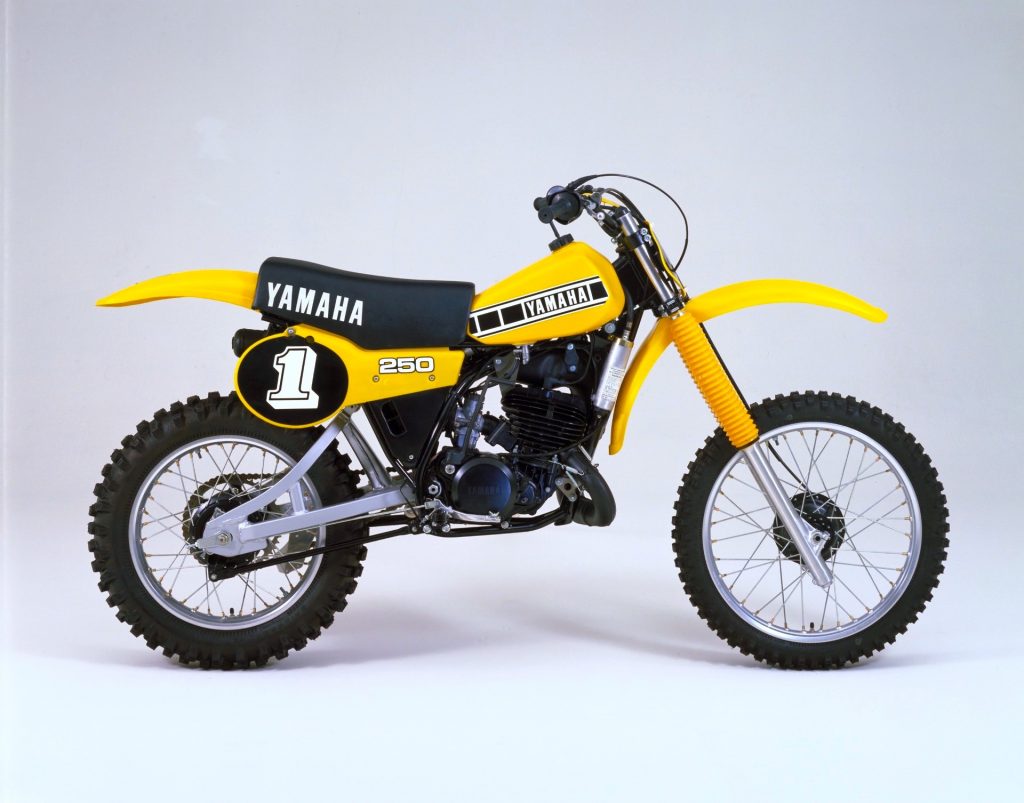 Although very similar in appearance to the 1979 YZ250F model, the new YZ250G was a whole new machine from stem to stern. Photo Credit: Yamaha
Although very similar in appearance to the 1979 YZ250F model, the new YZ250G was a whole new machine from stem to stern. Photo Credit: Yamaha
The seventies were a great decade for Yamaha. They helped usher in the off-road explosion in America with the DT-1 Enduro at the start of the decade, and kicked off a suspension revolution with their game-changing Monoshocks in 1975. From the time they introduced the works-replica YZs in May of 1973, they consistently remained at the top of the motocross charts in America. Multiple Supercross and National Motocross titles (including a sweep of all four major championships in 1978) stood as proof of Yamaha’s performance pedigree in the seventies.
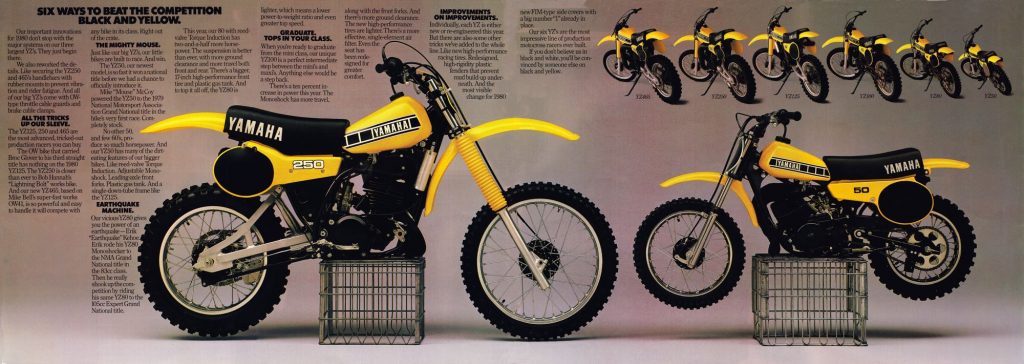 In 1980, Yamaha offered a huge lineup of Monoshock machines ranging from the tiny YZ50 all the way up to the ground-pounding YZ465. Photo Credit: Yamaha
In 1980, Yamaha offered a huge lineup of Monoshock machines ranging from the tiny YZ50 all the way up to the ground-pounding YZ465. Photo Credit: Yamaha
As the decade of the eighties approached, however, the motocross landscape began to change. With laid-down long-travel dual-shocks being the norm and rising-rate single-shocks on the horizon, the Yamaha “Mono’s” were no longer the significant advantage they had once been. Tall, top-heavy, and notorious for their affection for sudden unexpected (Yama) swaps, the Mono’s days at the top of the sport were coming to a close.
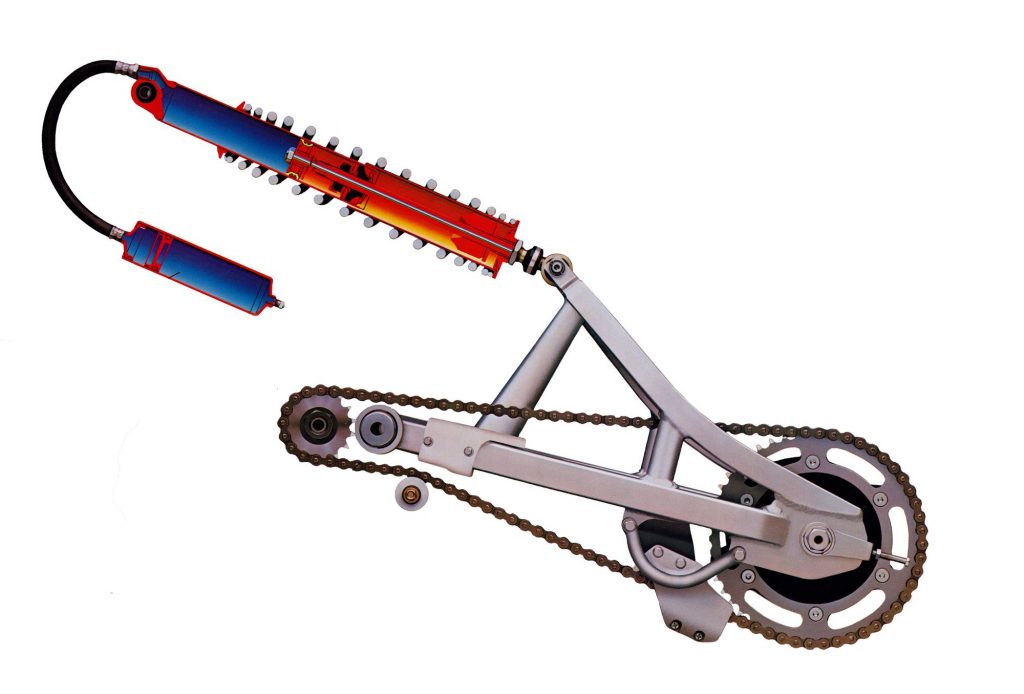 An all-new Monoshock design for 1980 reduced weight, improved handling, and simplified tuning. Photo Credit: Yamaha
An all-new Monoshock design for 1980 reduced weight, improved handling, and simplified tuning. Photo Credit: Yamaha
Seeing the writing on the wall, Yamaha set out in 1980 to try and address some of the more significant complaints riders had with the original Monoshock design. Chief among these were the bike’s the quirky handling and the shock’s propensity for fading. In order to achieve the impressive travel figures of the original Monoshock, Yamaha had laid its large single damper down the length the frame. The shock ran all the way from the swingarm to the base of the steering head and was housed in a tube that doubled as the frame’s backbone. While this provided a significant travel advantage, it also buried the shock deep inside the bodywork away from any cooling air. This placement also meant that a lot of heavy components were mounted high up on the frame. This made the damper prone to premature fading and gave the bike a top-heavy feel on the track.
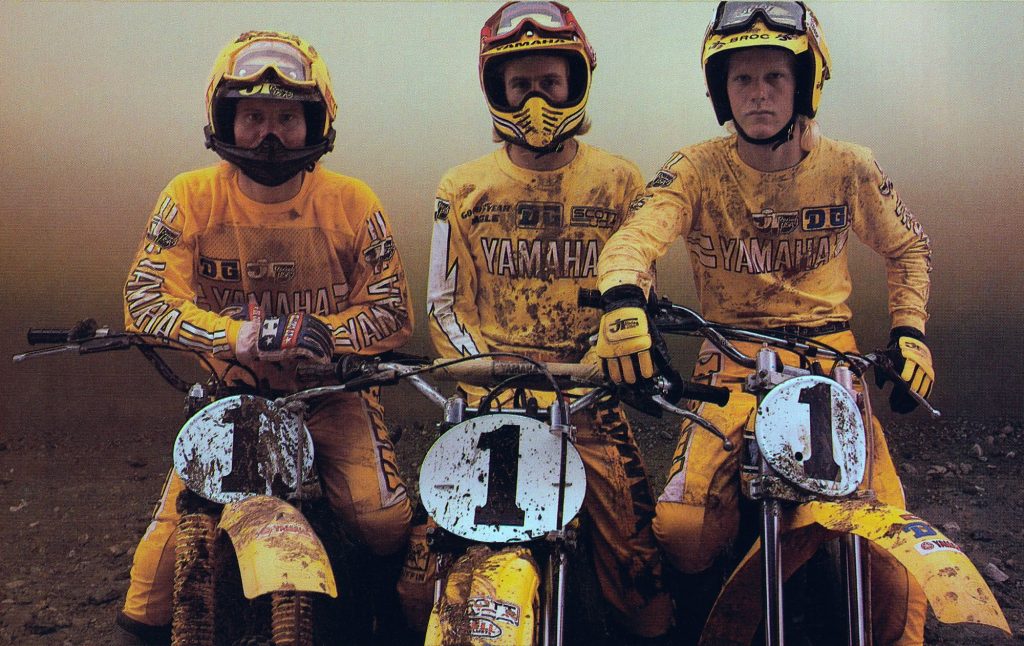 Yamaha was a powerhouse in the late seventies, dominating racing indoors and out with riders like Rick Burgett (left), Bob Hannah (middle) and Broc Glover (right) at the controls. Photo Credit: Yamaha
Yamaha was a powerhouse in the late seventies, dominating racing indoors and out with riders like Rick Burgett (left), Bob Hannah (middle) and Broc Glover (right) at the controls. Photo Credit: Yamaha
In order to rectify these issues, Yamaha dialed up an all-new Monoshock design for 1980. Although the basic configuration remained very similar, nearly everything else about it was all new. The new design retained the laid-down arrangement and large triangulated swingarm of 1979, but added a new shock that was lighter and more compact than before. The new damper was crafted from aluminum to save weight and featured a remote reservoir for the first time. A tried-and-true trick of the aftermarket, this reservoir increased the overall oil capacity of the shock and improved fade resistance by placing the remote canister on the frame downtube where it could get lots of cooling air.
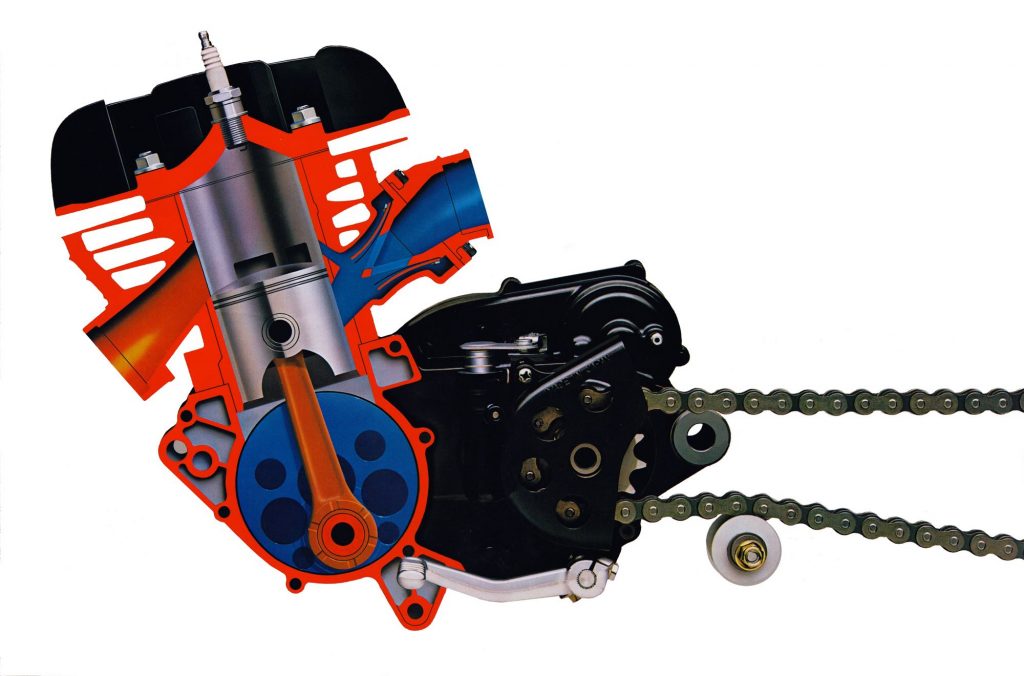 An all-new 246cc two-stroke motor for 1980 reduced the size and weight of the power plant, while boosting output significantly. Photo Credit: Yamaha
An all-new 246cc two-stroke motor for 1980 reduced the size and weight of the power plant, while boosting output significantly. Photo Credit: Yamaha
By offloading some of the oil capacity to the remote reservoir, Yamaha was also able to reduce the overall length of the shock significantly. This allowed them to further improve cooling by moving the shock out of the frame backbone and mounting it directly to the frame. Because the shock was shorter, it was also placed slightly lower on the frame for improved handling. To further reduce the top-heavy feel, Yamaha inverted the shock to place the spring at the bottom and installed a tapered spring to save a few ounces. As a side benefit, this also made tuning much easier by allowing preload and damping adjustments to be made without removing the shock.
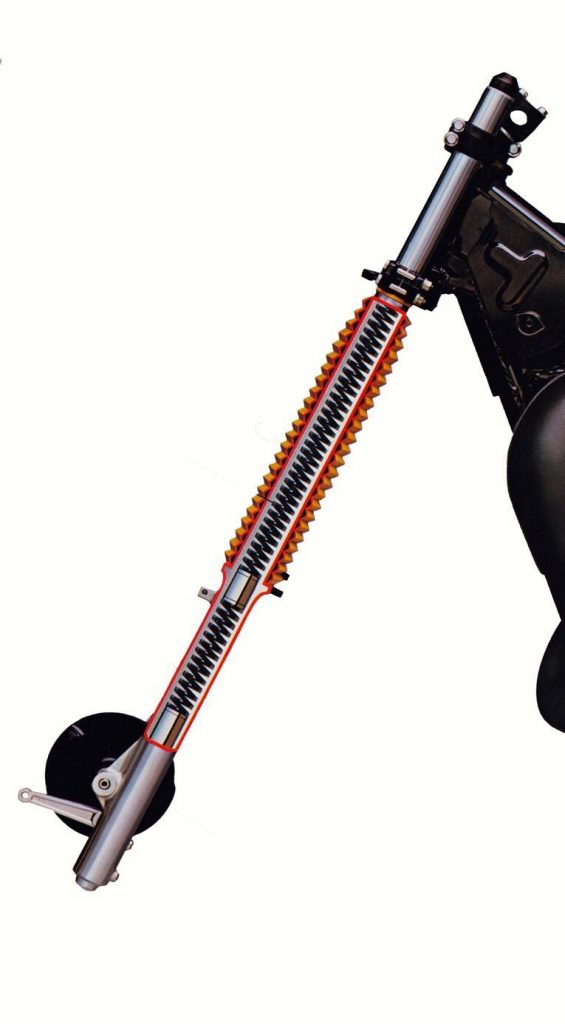 New air-assisted 38mm Kayaba spring forks boosted travel over an inch for 1980. Photo Credit: Yamaha
New air-assisted 38mm Kayaba spring forks boosted travel over an inch for 1980. Photo Credit: Yamaha
In order to accommodate this new rear suspension, Yamaha had to dial up an all-new chassis for 1980. The new chrome-moly steel frame deleted the double-cradle of ’79 and replaced it with a large single downtube to increase strength and reduce flex. Without the need to house the shock, the frame backbone was smaller in diameter and made of thicker tubing. This helped address one of the weak points of the ’77-’79 frames, which had suffered from cracks in this area. Overall, the new frame was lighter, stronger, more compact, and tuned to improve steering response over ’79.
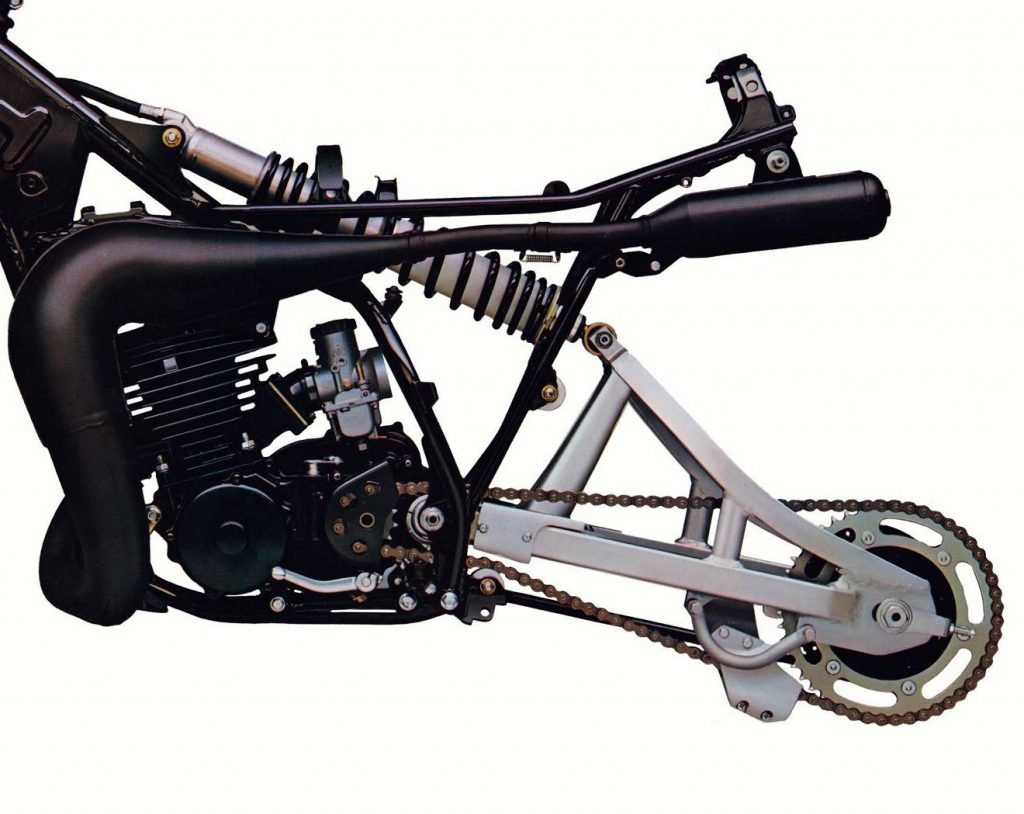 An all-new frame for 1980 steepened the steering angle slightly and repositioned the Monoshock lower on the frame to improve handling. Photo Credit: Yamaha
An all-new frame for 1980 steepened the steering angle slightly and repositioned the Monoshock lower on the frame to improve handling. Photo Credit: Yamaha
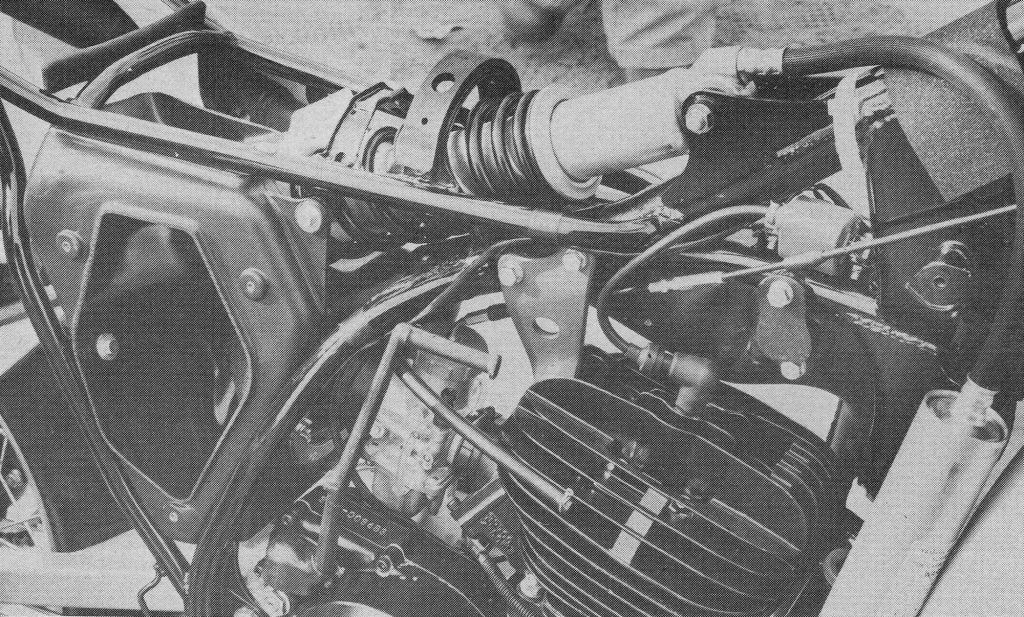 The new frame did away with the hollow frame backbone that housed previous Monoshock dampers. This increased the strength of the frame and allowed for better cooling of the shock. Photo Credit: Dirt Bike
The new frame did away with the hollow frame backbone that housed previous Monoshock dampers. This increased the strength of the frame and allowed for better cooling of the shock. Photo Credit: Dirt Bike
On the motor side of things, the YZ250G’s 246cc power plant was just as new as the rest of the machine. While the bore and stroke remained unchanged from 1979, the rest of the motor was a completely new design. The new cases on the “G” model were far smaller than the “F” had been and gave the mill an almost 125-like appearance. Inside that shrunken bottom end a new transmission housed six speeds and a new shift drum was added for improved action. In the top end, the G used a lightweight aluminum cylinder with a cast-in steel liner and two-ring piston. Internal porting was new for 1980, with a repositioned exhaust port (to accommodate the switch to a single downtube) and freer-breathing reed-valve. The reed material remained stainless steel, but opened 3mm farther for ’80 to increase the flow from the 38mm Mikuni mixer. Finishing off the power package were an all-new airbox, a redesigned pipe and a large (and loud) non-rebuildable steel silencer.
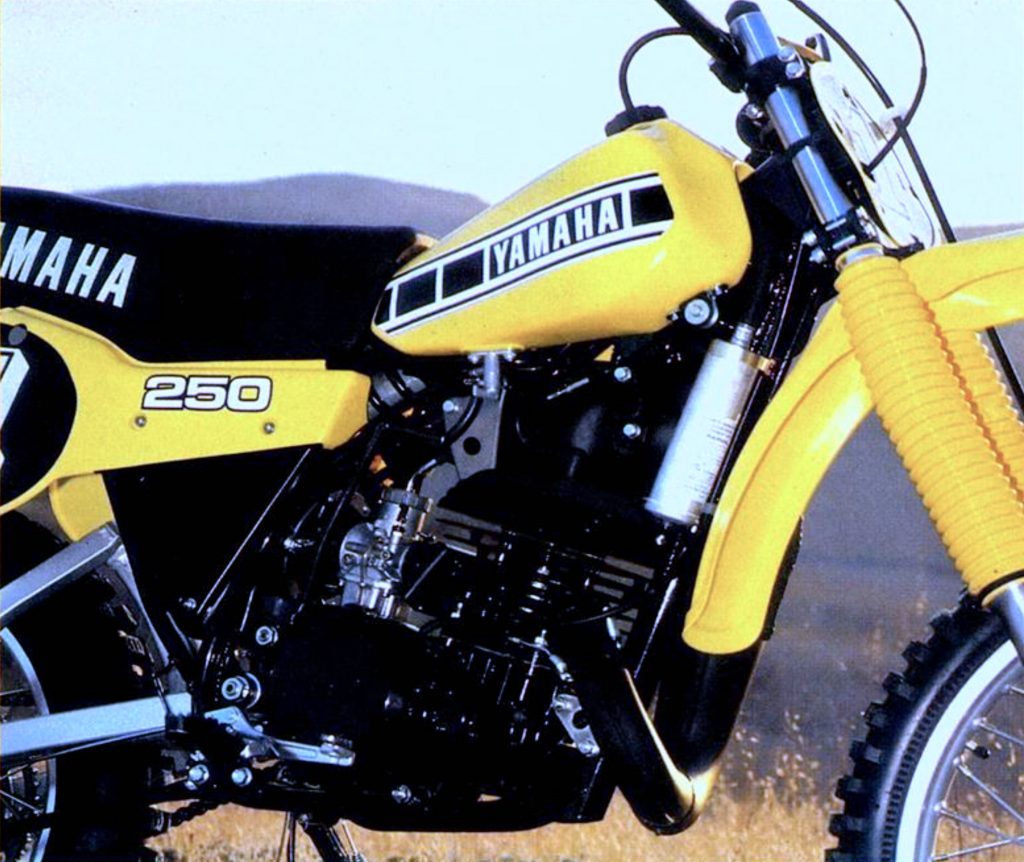 In addition to repositioning the shock, Yamaha added an external reservoir (seen here mounted to the main frame downtube) to increase oil volume and aid cooling. Photo Credit: Cycle World
In addition to repositioning the shock, Yamaha added an external reservoir (seen here mounted to the main frame downtube) to increase oil volume and aid cooling. Photo Credit: Cycle World
Even though the new YZ looked almost identical to 1979, the ’80 model featured all-new bodywork from stem to stern. The new fenders were thinner, lighter and slightly wider. A new seat offered a slightly lower seating position and a new tank looked the same as ’79, but was not interchangeable with the old model. The FIM-mandated extended side plates remained, but featured a revised shape and a slightly cleaner appearance.
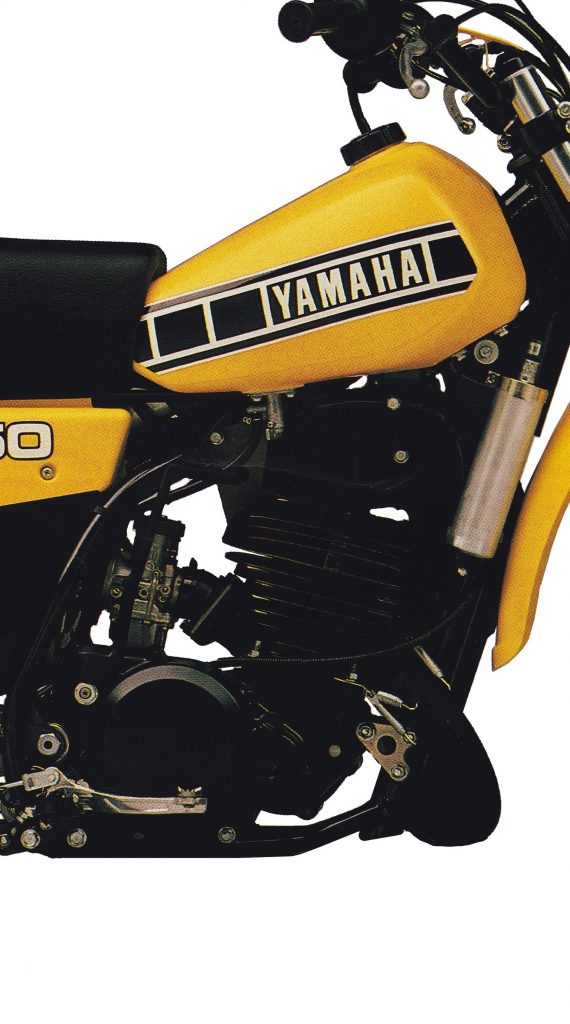 Moon shot: The 1980 YZ250G power plant offered an abrupt and pro-oriented style of power. There was not a lot of torque down low, but once it hit the midrange, it took off like a Saturn V rocket. Once on the pipe, no other 250 was going to keep it in its sights in 1980. Photo Credit: Yamaha
Moon shot: The 1980 YZ250G power plant offered an abrupt and pro-oriented style of power. There was not a lot of torque down low, but once it hit the midrange, it took off like a Saturn V rocket. Once on the pipe, no other 250 was going to keep it in its sights in 1980. Photo Credit: Yamaha
In terms of performance, the 1980 YZ250G turned out to be a significant upgrade over the F model in most respects. The new chassis was nimbler and felt lighter than any YZ since the feather-weight original in 1974. Turning was much-improved over ’79 and the bike tracked straight in the rough as long as you kept the power on. If you backed off, the G model still exhibited the occasional Yama-swap, but it was far less frequent than in the past. Overall, most testers felt that the YZ250G offered the best handling package in the 250 class in 1980.
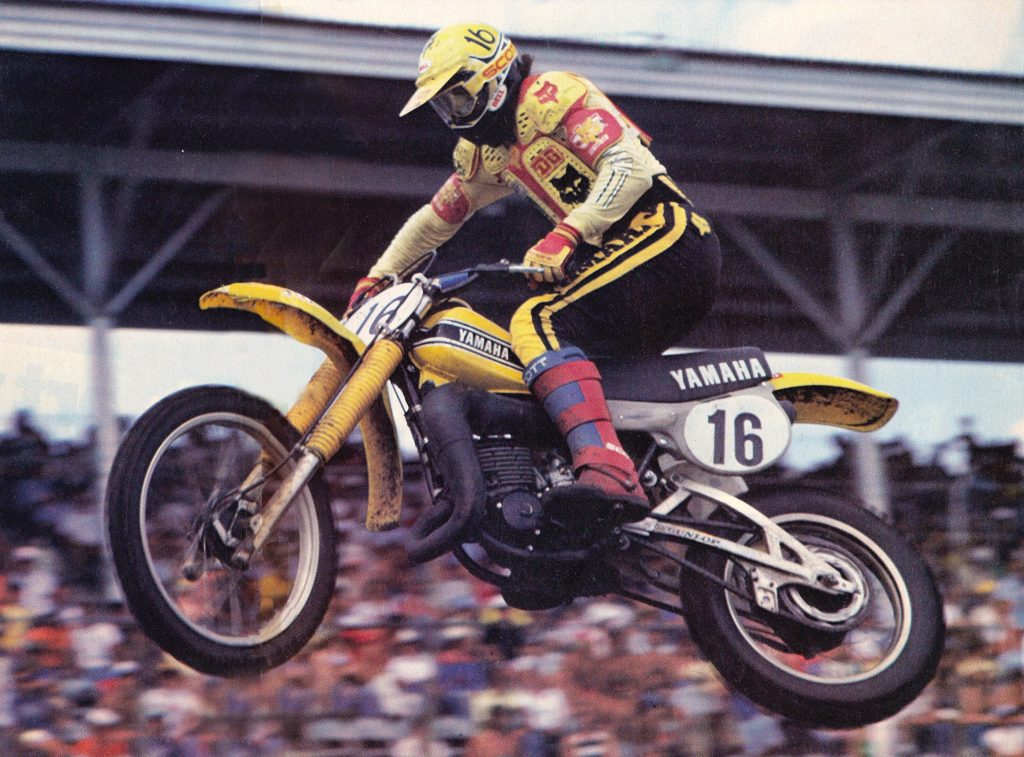 With superstar Bob Hannah sidelined from a nasty water-skiing crash, it was up to Mike “Too Tall” Bell and “Rocket” Rex Staten to keep the Supercross title in Yamaha’s hands. At Daytona, Staten was able to hold up his end of the bargain by taking his works Yamaha OW40 to the win. Photo Credit: Unknown
With superstar Bob Hannah sidelined from a nasty water-skiing crash, it was up to Mike “Too Tall” Bell and “Rocket” Rex Staten to keep the Supercross title in Yamaha’s hands. At Daytona, Staten was able to hold up his end of the bargain by taking his works Yamaha OW40 to the win. Photo Credit: Unknown
On the motor front, the new YZ offered a much more potent power package than 1979. The new G motor lacked the solid low-end torque of the YZ250F, but made up for it with a strong mid-range and blistering top-end pull. Off the line, it was purely pedestrian, but once it climbed on the pipe, it waved bye-bye to every other bike in the class. Because of its lack of torque and abrupt hit, it was tricky to keep on the pipe and far more demanding to ride than the mellower ’79 had been. Out of corners, the front end of the YZ tended to get very light and if you wacked open the throttle injudiciously, the potent midrange blast was likely to put you on your backside. This made the bike a bit of a handful for novices but a potent weapon for those with the skill to make the most of its prodigious thrust.
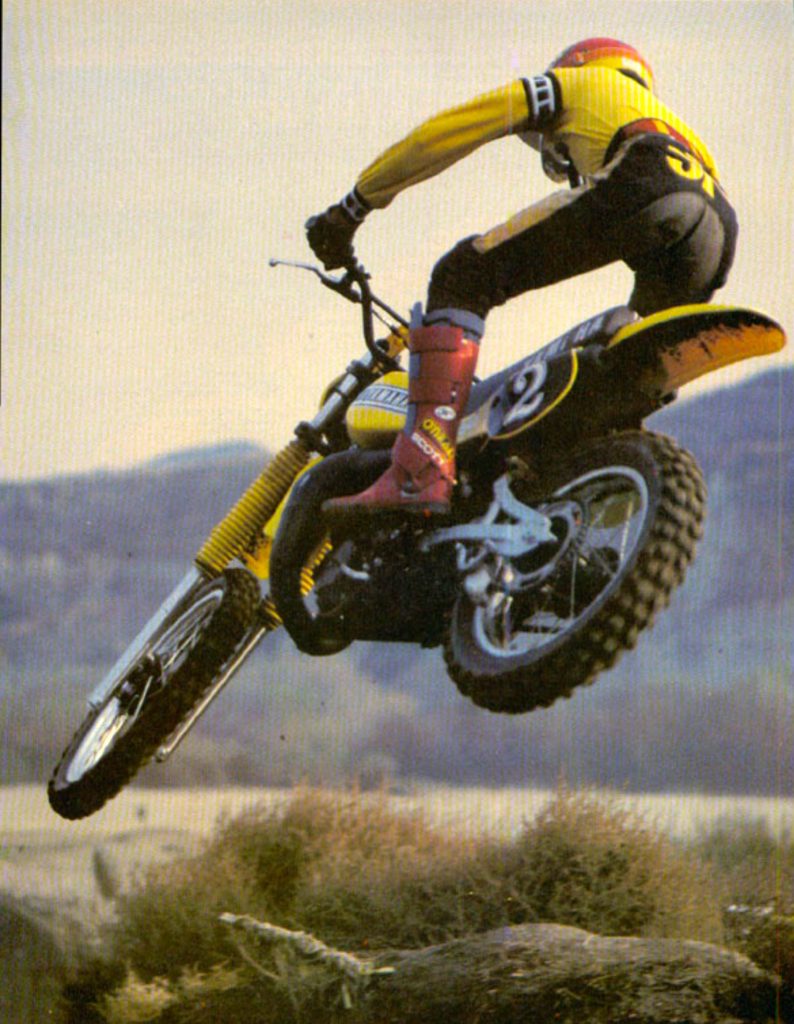 With ample power and a light 214-pound fighting weight, the 1980 YZ250G was a capable flyer. Photo Credit: Cycle World
With ample power and a light 214-pound fighting weight, the 1980 YZ250G was a capable flyer. Photo Credit: Cycle World
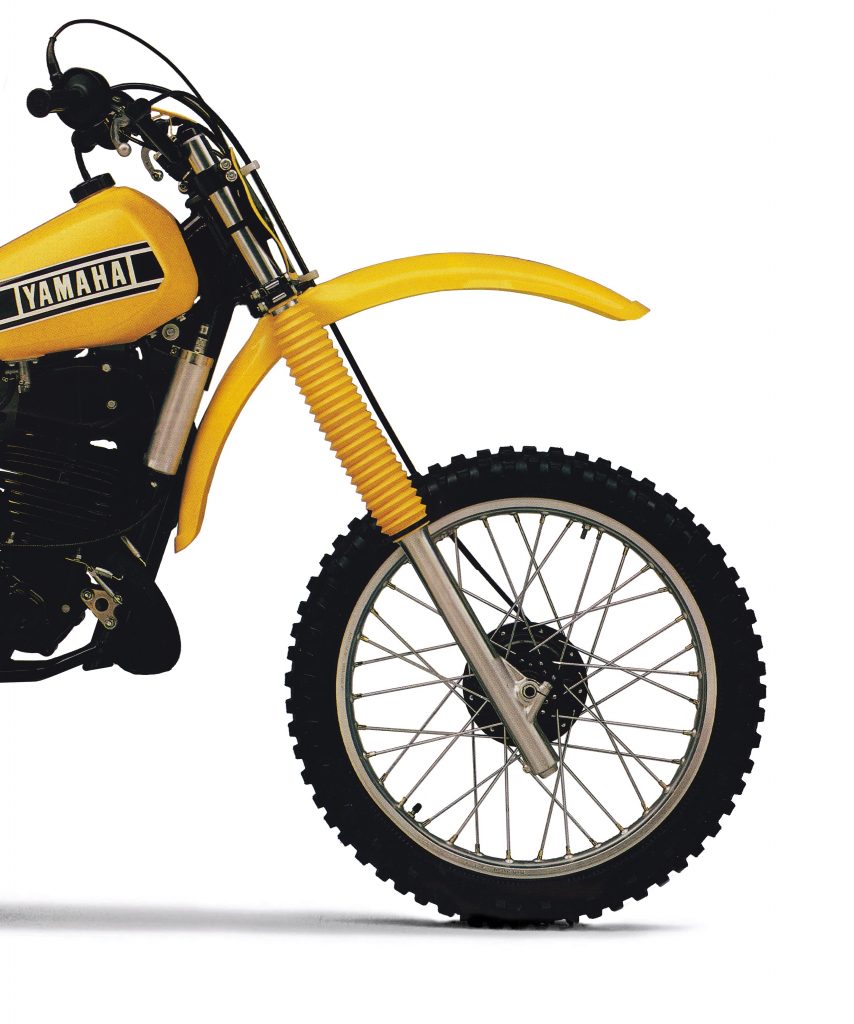 With 11.8-inches of travel and plush action, the YZ250G’s 38mm forks were considered some of the best units in the class. Photo Credit: Yamaha
With 11.8-inches of travel and plush action, the YZ250G’s 38mm forks were considered some of the best units in the class. Photo Credit: Yamaha
On the suspension end of things, the new G model offered an impressive 11.8-inches of travel from its 38mm Kayaba forks. This was an increase of over an inch over 1979. The new forks offered no external adjustments for compression or rebound, but did allow fine some fine-tuning through air-pressure (as a supplement to the coil springs, not a replacement). If you actually wanted to adjust the fork’s damping, the only option was to change the volume and viscosity of the oil.
 A new hub saved weight, but a downsizing in brake surface area led to mediocre performance. Photo Credit: Cycle World
A new hub saved weight, but a downsizing in brake surface area led to mediocre performance. Photo Credit: Cycle World
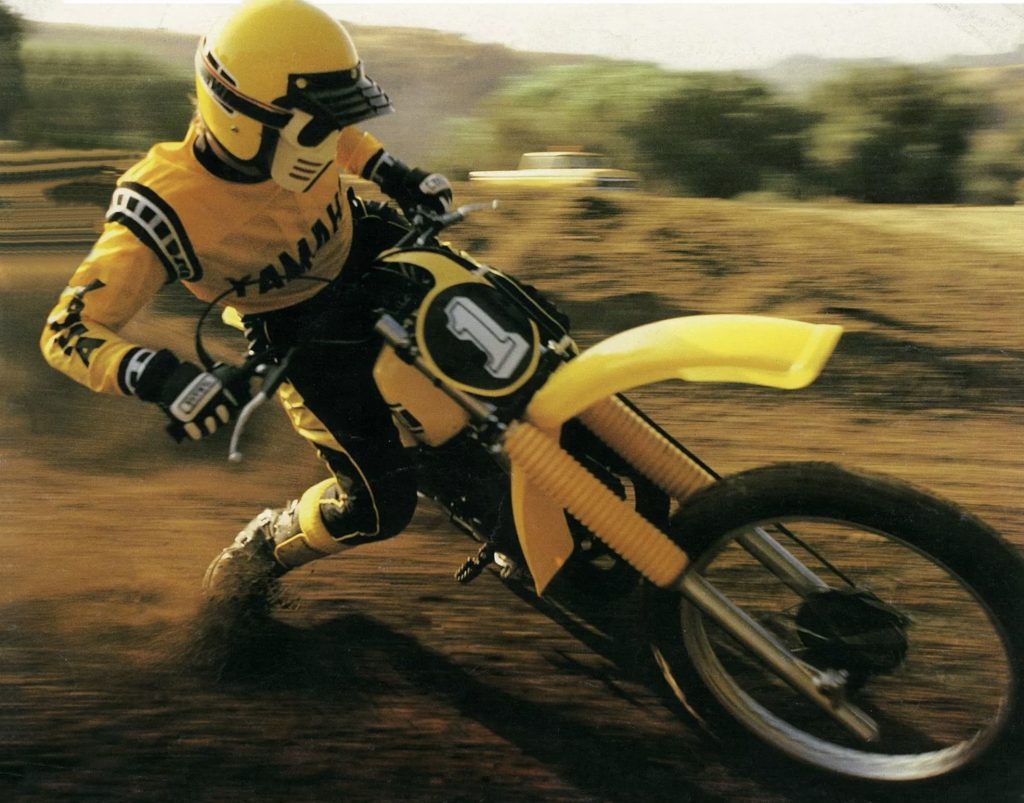 Hammer down: With its potent powerband, the YZ250G could be a handful for those of lesser skill to manage. Photo Credit: Yamaha
Hammer down: With its potent powerband, the YZ250G could be a handful for those of lesser skill to manage. Photo Credit: Yamaha
Out back, the new Monoshock offered the same 11.8-inches of travel as the front forks. This was nearly 1.5-inches more than 1979. External adjustments were limited to spring preload and a 24-position rebound clicker at the base of the shock. Compression damping was set and could not be altered without changing the shock’s internals.
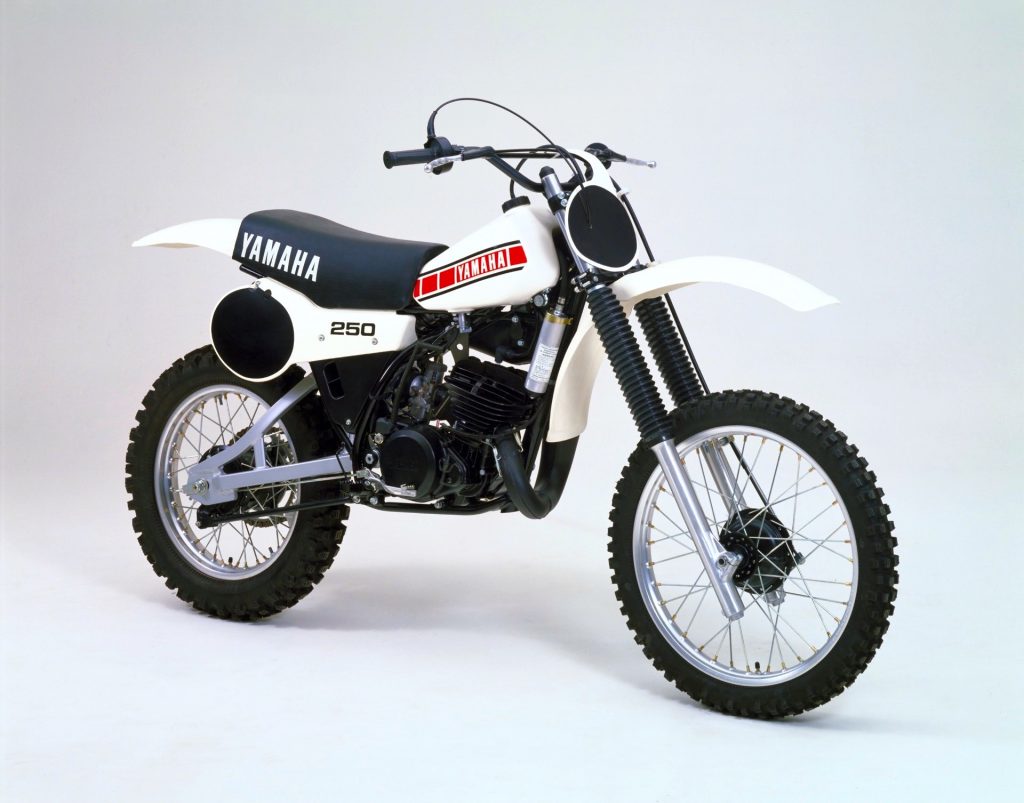 Fraternal Twins: Throughout the seventies and early eighties, YZs outside of the US were offered in this classy white and red, while US-bound models stuck to yellow and black (they also did not get the slightly gimmicky big number ones on the plates, a nod to the sweep of US titles Yamaha accomplished in 1978). In 1985, Yamaha USA finally dropped the bumble bee color scheme and went with the international white and red known to riders around the globe. Photo Credit: Yamaha
Fraternal Twins: Throughout the seventies and early eighties, YZs outside of the US were offered in this classy white and red, while US-bound models stuck to yellow and black (they also did not get the slightly gimmicky big number ones on the plates, a nod to the sweep of US titles Yamaha accomplished in 1978). In 1985, Yamaha USA finally dropped the bumble bee color scheme and went with the international white and red known to riders around the globe. Photo Credit: Yamaha
On the track, the YZ250G’s suspension proved some of the best in the business in 1979. Both ends were quite plush, with excellent control and good bottoming resistance. By modern standards, both ends were incredibly soft, but by the standards of the time, they were more than adequate for racing anywhere below the pro class. As long as you kept the power on, the new Mono tracked straight and true, gobbling up whoops and stutters easily. With its new remote reservoir, fading was much improved and the shock maintained consistent damping far longer than before. Pros, of course, were likely to opt for a FOX, White Bros or Luft shock, but for average Joes, it was an excellent damper.
 While its days were clearly numbered, the tried and true Monoshock did an ample job of absorbing the track in 1980. The arrival of new rising-rate systems like the Uni-Trak, Pro-Link, and Full Floater would make this seventies icon obsolete within the next few years. Photo Credit: Yamaha
While its days were clearly numbered, the tried and true Monoshock did an ample job of absorbing the track in 1980. The arrival of new rising-rate systems like the Uni-Trak, Pro-Link, and Full Floater would make this seventies icon obsolete within the next few years. Photo Credit: Yamaha
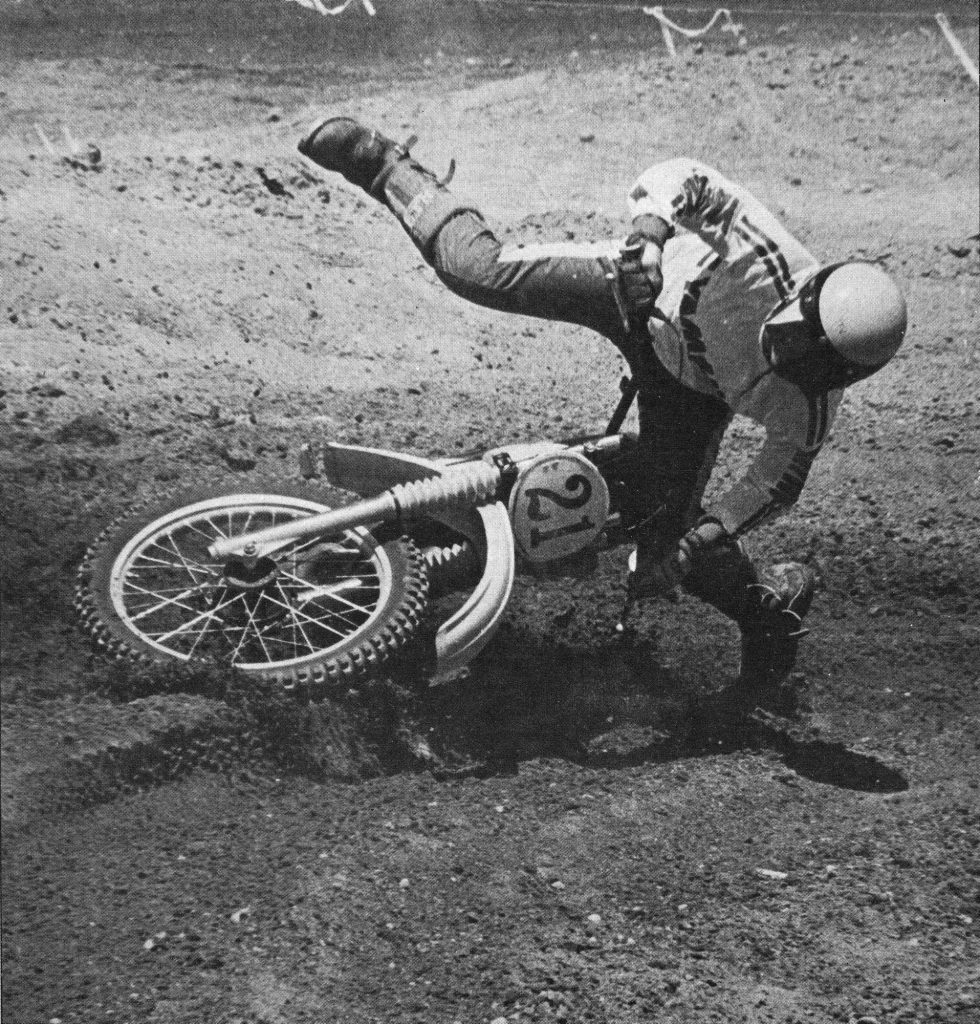 Early Monoshock YZs were never known for their turning prowess, but the 1980 YZ250G model changed a lot of those perceptions with an excellent handling package. Photo Credit: Ron Randolph
Early Monoshock YZs were never known for their turning prowess, but the 1980 YZ250G model changed a lot of those perceptions with an excellent handling package. Photo Credit: Ron Randolph
On the detailing front, the new YZ250G was very good for its time. Cool little dimples molded into the hand levers form-fit to your fingers and made them very comfortable. The alloy rear brake lever was just as trick as the hand levers and featured a wrap-around design that snaked inside the frame rails and looked like something off of Bob Hannah’s OW racer. The brakes themselves were a mixed bag, with a strong front and mediocre rear. The full-floating rear in particular annoyed riders with its propensity to chatter and become grabby when hot. For once, the tank decals actually lasted past the first ride and proved far more durable than in the past. The bike was also far narrower than the Honda and Suzuki, a side benefit of the Monoshock design.
 Even without the benefit of the YZ465’s works-like dual-leading shoe blinders, the YZ250G offered one of the best front brakes in the class. Photo Credit: Cycle World
Even without the benefit of the YZ465’s works-like dual-leading shoe blinders, the YZ250G offered one of the best front brakes in the class. Photo Credit: Cycle World
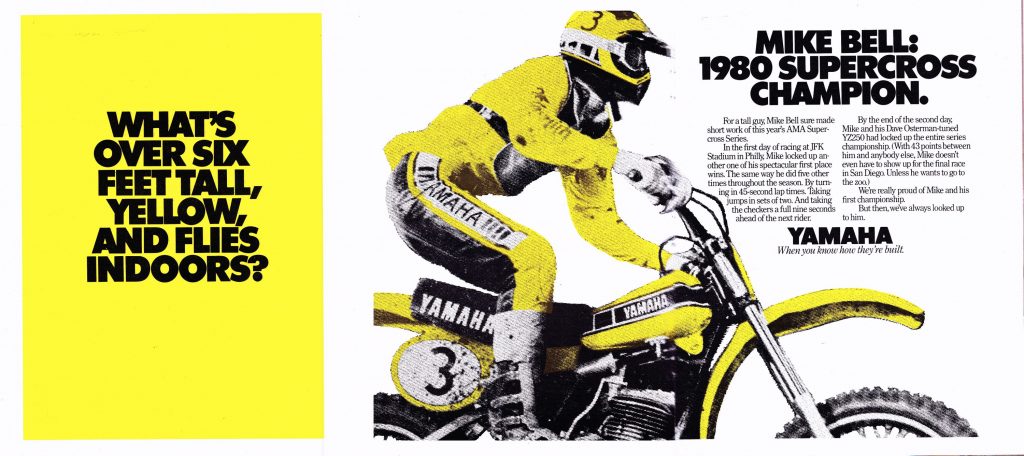 In 1980, Mike Bell captured Yamaha’s fourth straight Supercross title. Photo Credit: Yamaha
In 1980, Mike Bell captured Yamaha’s fourth straight Supercross title. Photo Credit: Yamaha
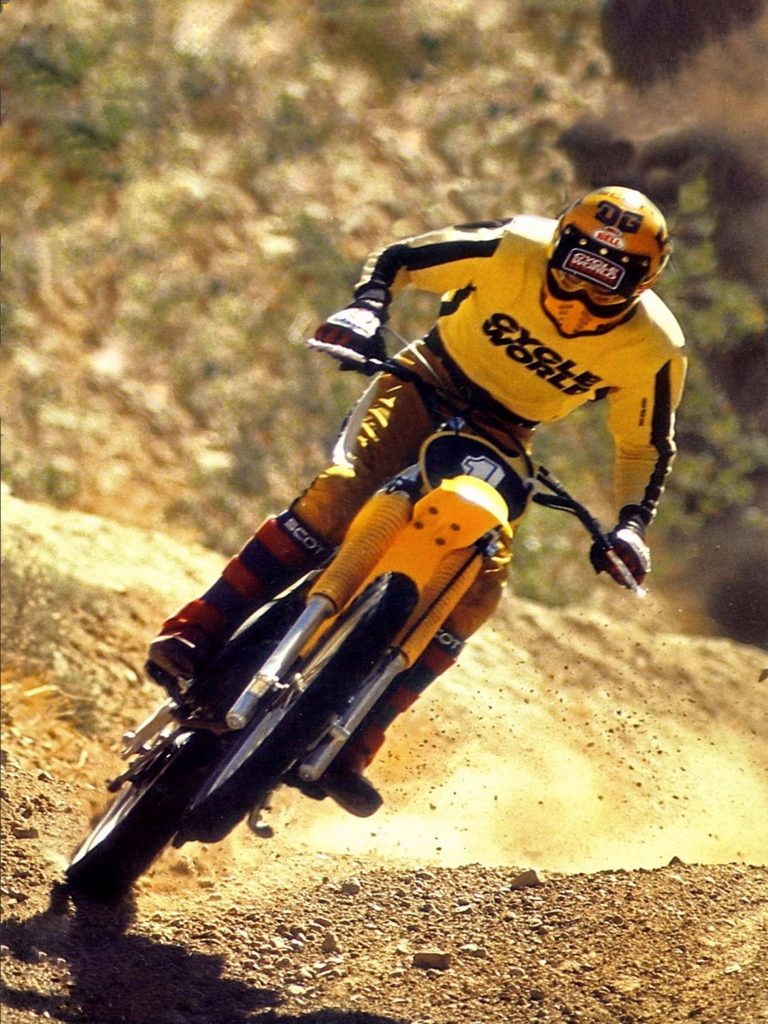 Fast guys could really make the YZ250G sing in 1980. Credit: Cycle World
Fast guys could really make the YZ250G sing in 1980. Credit: Cycle World
Even though it did not change much visually from 1979, most people at the time approved of the Yamaha’s classic looks. The new fenders offered better mud protection and appeared much more elegant than the heavily braced ’79 units. The big alloy swingarm on the YZ looked cool and rarely suffered failures, something that could not be said of much of the YZ’s competition. The new lower seat height and revised bar bend were appreciated by those of shorter stature, but anyone over six feet tall was likely to find the new ergonomics very cramped (Lord only knows what Dave Osterman had to do to shoehorn Mike “Too Tall” Bell’s 6’4” frame into this chassis).
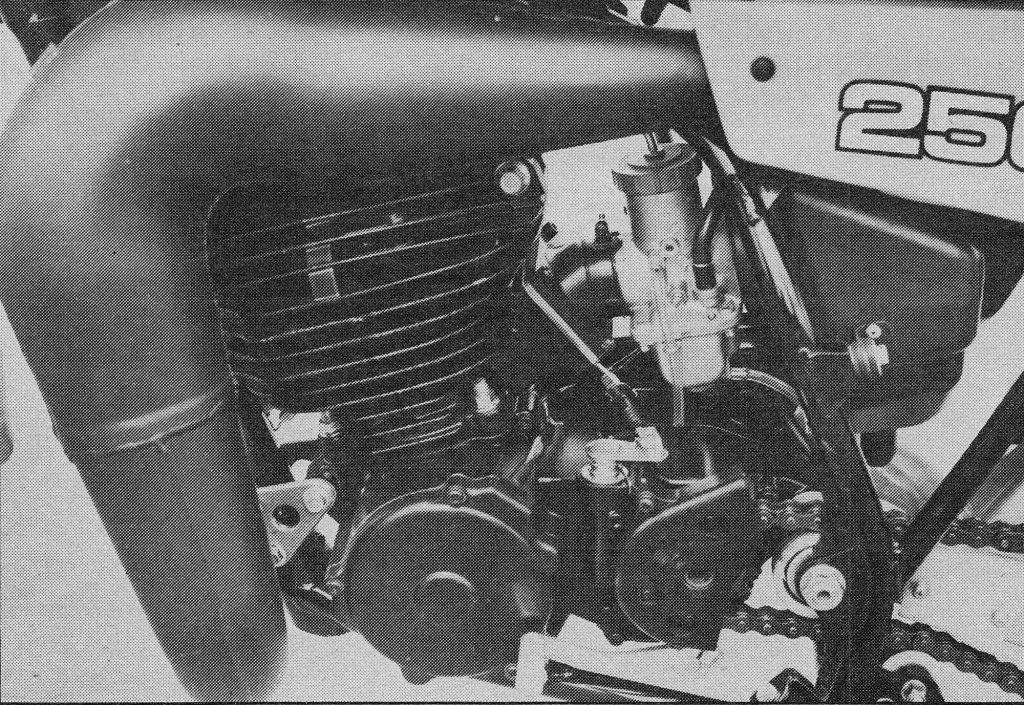 With its versatile six-speed transmission and top-end thrust, the YZ250G made a tempting desert mount in 1980. For riding back East, a heavier flywheel and a boost in low-end torque were sure to be on the wish list for Dick Burleson wannabes. Photo Credit: Dirt Bike
With its versatile six-speed transmission and top-end thrust, the YZ250G made a tempting desert mount in 1980. For riding back East, a heavier flywheel and a boost in low-end torque were sure to be on the wish list for Dick Burleson wannabes. Photo Credit: Dirt Bike
Even though the overall bike was pretty great for 1980, there were a few quibbles. The clutch, while durable, was an absolute bear to use. It felt much more like something from a European 500 than from a typical Japanese 250 and gave riders hand cramps in short order. With its six-speed trans and potent output, the YZ250G was incredibly versatile, but prone to constant pinging on pump gas; race gas was a must if you wanted to keep your yellow powerhouse in one piece. The new airbox also proved problematic, with a tendency to eject the cover’s bottom screw and let in all manner of detritus; it was best to check this constantly and add a bead of silicone for added insurance.
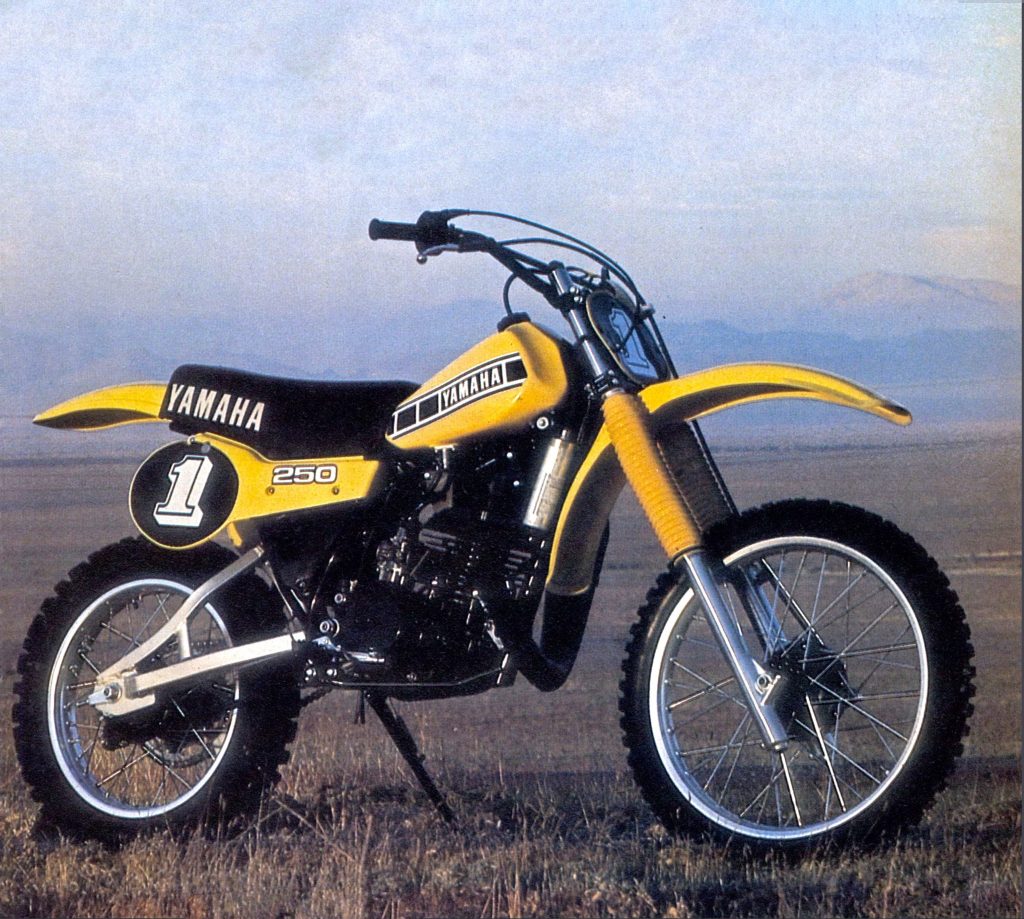 In 1980, Yamaha released an all-new YZ250 with old-school looks and new-school performance. Light, fast and well-suspended, the 1980 YZ250G was the best 250 of 1980 and the best Yamaha for nearly a decade to come. Photo Credit: Cycle World
In 1980, Yamaha released an all-new YZ250 with old-school looks and new-school performance. Light, fast and well-suspended, the 1980 YZ250G was the best 250 of 1980 and the best Yamaha for nearly a decade to come. Photo Credit: Cycle World
Overall, the 1980 Yamaha YZ250G stands as the high-water mark for the original Monoshock YZs; the culmination of half a decade of refinement and innovation. With the coming arrival of linkages and rising-rate rears, its days were numbered, but in 1980, it still had what it took to propel the Why-Zed to the top. With a powerful pro-oriented motor, sharp turning, and superb suspension, the YZ250G was the class of the field in 1980 and a fitting way to finish off a decade of Yamaha excellence.
For your daily dose of old-school moto goodness, make sure to follow me on Twitter and Instagram – @TonyBlazier
For questions or comments, feel free to drop me a line anytime at TheMotocrossVault@Gmail.com


